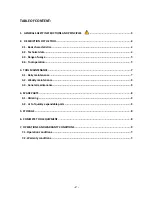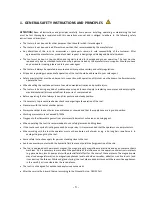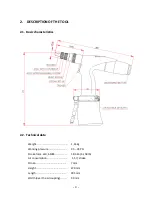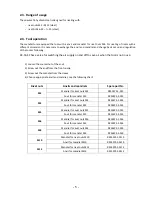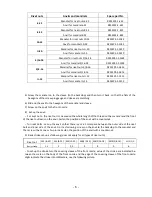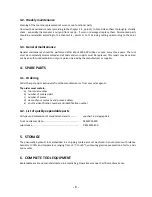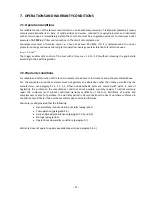
- 3 -
1. GENERAL SAFETY INSTRUCTIONS AND PRINCIPLES
ATTENTION!
Read all instructions and principles carefully. Every person installing, operating or maintaining the tool
must be first thoroughly acquainted with this operations manual and is obliged to adhere to the following safety
instructions and principles:
The tool must not be used for other purposes than those for which it was designed.
The tool must not be used in a different manner than that recommended by the manufacturer
Any alterations of the tool, its accessories or spare parts remain in sole responsibility of the customer. After
agreement the manufacturer provide technical support in designing and making additional alterations.
The tool must be kept in top condition and regularly tested for damage and proper operation. The tool must be
repaired only by an authorized technician or by a person trained by the manufacturer or supplier. Should you have
any demand for training, please contact your sales agent.
The tool must always be operated in accordance with respective sanitary and safety regulations.
All queries regarding proper and safe operation of the tool should be addressed to your sales agent.
Safety principles that must be adhered to in connection with operation of this tool must be known to all workers who
operate the tool.
When handling the tool take extra care to avoid unwanted activation and possible injury.
The tool must be during any kind of maintenance or repair (does not apply to replacing nose‐pieces and emptying the
mandrel container) disconnected from the source of compressed air.
Before operating the tool always take up firm posture and steady position.
It is necessary to prevent break‐away shanks endangering safe operation of the tool.
Never aim with the tool at another person.
Always check that the vent holes are not blocked or covered and that the supply hose are in good condition.
Working pressure must not exceed 0,7 MPa.
Oxygen or other flammable gasses from pressure cylinders must not serve as a driving agent.
When operating the tool it is recommended to use safety glasses and utility gloves.
If the continuous cycle of riveting exceeds 8 hours per day, it is recommended that the operators use ear protectors.
When working with the tool the operator must not have loose parts of wear as e.g. a tie, long hair, jewellery etc. to
avoid getting caught by the tool.
Same safety instructions apply for persons standing close to the tool.
Avoid unnecessary contact with the hydraulic fluid to prevent possible allergy reaction of the skin.
The tool is equipped with permanent magnet, the magnetic pole may influence electronic and even some mechanic
machines. So it is necessary to warn about the possibility of the influence on the operation of electronic implants
(e.g. pacemakers, insulin pumps etc.) with potential fatal effect for the users of these implants. The magnetic pole
may also damage information on magnetic appliances (audio and video cassettes, diskettes, credit cards etc.) and
it can destroy the forever. While using (and storing) the tool, please, keep distance with these sensitive appliances,
in this case 0,5 m is considered as the save distance.
The tool is not designed for outdoor and explosive environment.
After the service life, discard the tool according to the Disposal Act no. 185/01 Coll.


